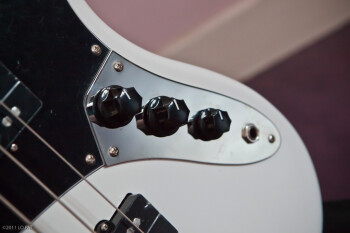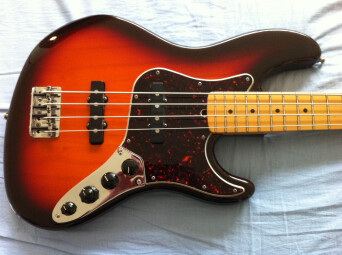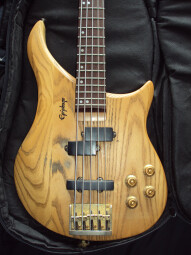Even with a very flexible amp that allows for an easy, fast and effective sound control, your audio chain always starts with your instrument and depends on your instrument settings.
You can tweak the EQ of your amp for hours, but if you don’t know which pickup to use and how to set the tone controls of your bass you’ll hardly find the right tone. Here is some basic knowledge to understand how a passive bass guitar works and how to get it under control.
Pickups are your friends
The pickup combination varies depending on the instrument you’re playing, Generally speaking, a bass guitar features one or two pickups. In most cases, if your bass has only one pickup it means you either have a precision kit or a dual-coil pickup. Bass guitars with two pickups offer one of the following combinations: two single-coil pickups, one single-coil plus one dual-coil pickup, or two dual-coil pickups. We won’t describe here the features of each combination because it has already been done in a previous article.
However, I’d like to remind you of one of the most crucial factors: regardless of the pickup technology, the position of the pickup on the instrument has a big effect on the sound. If the pickup is close to the neck, it captures a wide string vibration. Conversely, if the pickup is close to the bridge, it will capture a narrow string vibration. As a consequence, the neck pickup is recommended for low-pitched sounds while the bridge pickup sounds better for higher-pitched sounds.
King Pot
The settings on a passive bass guitar allow you to control the volume and tone of the instrument. To set the level of a pickup, just turn the dedicated volume control. If your bass has two pickups, you’ll have either two volume controls or only one plus a balance control that mixes both pickup signals.
You own the tone
Additionally to the volume control(s), your bass also features one or two tone pot(s). Most often than not, you’ll have a single tone control for the overall sound. Actually a passive tone-control design uses a basic electronic component called a capacitor. Once it is soldered to the potentiometer, it filters high frequencies out and sends them to the circuit ground. In other words, the tone control allows you to open a kind of high-cut filter.
Let’s keep it simple: when you turn the tone control clockwise, you get a brighter sound. When you turn it counterclockwise, the signal is “deeper”. However, the tone control doesn’t affect only highs and lows. In fact, it also affects mid-frequencies depending on the pickup.
The right balance
Once you understand the role of each pickup on your bass guitar and how to control them, you must familiarize yourself with all setting subtleties. I recommend you to set your amp EQ flat or even to disable it in order to perceive every sound nuance of your instrument. Beginners ought to keep it simple to get to know the natural tone of their instrument as quickly as possible. If you already master several playing techniques, try them all out with these settings.
Play a bass line you like. Two bars will be enough. Play this line in a loop and start with all volume controls fully open and the tone pot in the center position. Now disable the bridge pickup and play the same line again. Afterwards disable the neck pickup. It’s easy to notice that the sound is usable in every pickup combination, and also that it has specific frequencies and colors depending on the pickup combination. Now, open both volume controls a bit and play again. Adjust the volume of both pickups by balancing their signals: you should be able to hear the things you like about each single pickup and what you’re missing when one pickup is turned off. That’s how you set the balance between both pickups.
If your bass guitar has only one single pickup, you can start adjusting the tone right away. To do so, you’ll have to find the right balance once again, even if turning the tone control fully on or off seems to work too. The right tone setting will allow you to adjust the balance between both pickups, making it more consistent. The goal is to find a tone that will be recognized and heard by the audience. The sound of your bass ought to be clearly distinguishable from other instruments and not overshadow them. The right tone setting for your bass line should emphasize the frequencies you want to hear without masking the others.
I proceed this way every time I review bass guitars for AudioFanzine in order to hear the instrument I’m playing (hearing also means understanding). This workflow will allow you to find the right tone with every passive bass guitar and playing technique (slap, tapping, pick or finger picking). If you change your playing technique within a song, I recommend you to find a setting that works in almost any situation. That way you won’t have to turn the controls on your bass every time you get to the chorus and you will also be able to focus on your playing. The preamp and amp settings allow you to improve the tone of your instrument and adapt it to the place where you’re playing and the band you’re playing with. But that’s a topic we’ll deal with in an upcoming article!



